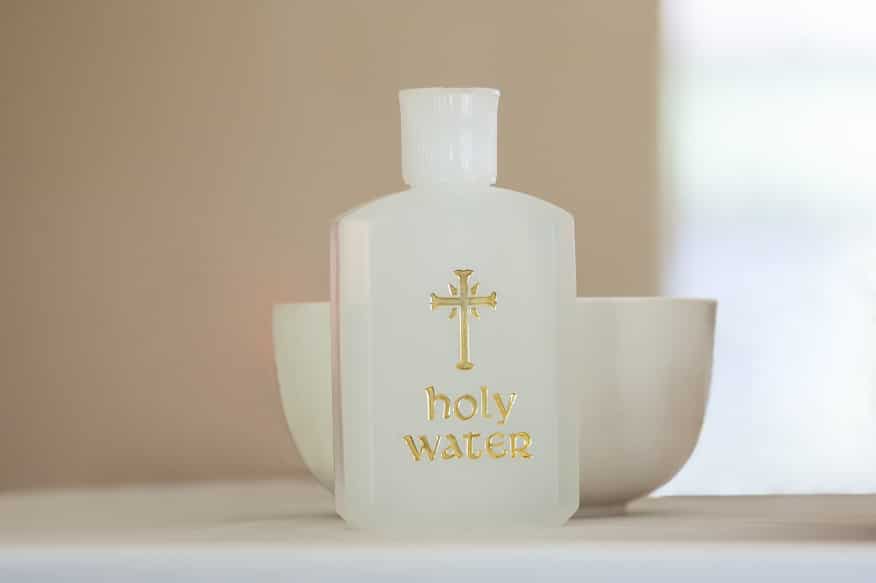Divine Retreat Centre UK – Official Website

Is Santa Claus real?
November 30, 2023
Children’s Liturgy – 32nd Sunday – The importance of wisdom and preparedness in our spiritual lives
December 4, 2023Holy Water is a customary feature in Catholic and some Orthodox Churches, used in churches, homes, and for personal devotion. But is Holy Water mentioned in the Bible? Is its use a Christian tradition that aligns with biblical teachings?
In many churches, Holy Water is placed in a small vessel or bowl at the entrance. Upon entering, it is common for worshippers to make the sign of the cross with Holy Water on their forehead. This practice prompts us to consider what is unique about Holy Water.
Holy Water is employed to bless people, homes, household items, and objects we use daily. This practice, stemming from both the Old and New Testaments, demonstrates God’s use of physical materials for healing, deliverance, and blessing. In the present day, sacraments and sacramentals, including Holy Water, are mediums through which we experience grace.
The Catholic Church acknowledges seven sacraments: Baptism, Confession, Eucharist, Confirmation, Holy Orders, Matrimony, and Anointing of the Sick. These sacraments are avenues for receiving God’s grace.
Similarly, sacramentals such as Holy Water are used in blessings. While sprinkling Holy Water does not confer grace directly, it serves to purify and prepare us for receiving the grace of the sacraments.
The Bible provides numerous examples of God using physical elements for purification and healing. In 2 Kings 5, the story of Naaman, the army chief of Aram, is told. Despite the Jordan River’s muddy appearance, its waters healed Naaman’s leprosy following Elisha’s instructions. This story shows that even seemingly unclean waters can possess sacred and cleansing qualities.
Another biblical instance is found in 2 Kings 2:19-22, where Prophet Elisha purifies a city’s water supply with salt. This ancient practice informs the current ritual of blessing water in the Church.
In the book of Exodus (15:22-25), Moses turns bitter water into sweet by casting a piece of wood into it, illustrating that God often provides simple solutions to our challenges.
In the New Testament, Acts 19:11-12 describes how objects touched by Apostle Paul healed people and expelled evil spirits, underscoring the potency of sanctified objects.
Ezekiel 36:25 prophesies God’s promise to cleanse His people with pure water, a metaphor for the purifying power of Jesus Christ.
Holy Water serves several purposes: it cleanses, delivers from evil, and reminds us of our liberation from sin. Esteemed saints, including Faustina, Teresa of Avila, John Maria Vianney, and Padre Pio, have attested to the profound efficacy of Holy Water.
St. Faustina’s Diary (entry 601) narrates an instance where she used Holy Water to dispel dark spirits. Similarly, St. Teresa of Avila’s Autobiography (Chapter 31) recounts her use of Holy Water to ward off evil.
While Holy Water in itself does not possess magical powers, its significance lies in its symbolism and consecration. It reminds us of our baptism and reaffirms our identity as God’s children. It signifies purification and protection, set apart from ordinary water.
In Zechariah 13:1, a prophecy mentions a cleansing fountain, symbolizing Jesus as the living water. Jesus’ declaration in John 7:37-38 about offering living water to those who believe in Him underscores this symbolism.
Keeping Holy Water in homes is a practice rooted in tradition and faith. It serves as a tool for blessing and protection, reflecting our royal priesthood as believers. Its use in the Church and homes continues a long-standing tradition of sanctification and spiritual fortification.
In summary, Holy Water is a meaningful aspect of Christian practice, deeply rooted in biblical teachings and Church tradition. Its use in various forms of blessings and rituals underscores its enduring significance in the life of the faithful.




